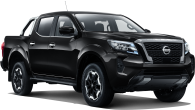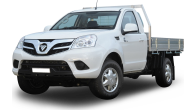The Holden Colorado range has seen the addition of a new variant - but it’s not exactly a brand-new badge.
The new Colorado LSX is now a permanent member of the range, after having been introduced as a special edition model in 2018. It was previously limited to 1000 units, but it’s now a full-time member of the line-up.
So as the model that splits the difference between the basic LS and plusher LTZ, is the LSX the Colorado you should choose if you want a ute that can handle work and play? Let’s find out.
Holden Colorado 2020: Ls-X (4X4)
| Engine Type | Diesel Turbo 4, 2.8L |
|---|---|
| Fuel Type | Diesel |
| Fuel Efficiency | 8.7L/100km (combined) |
| Seating | 5 |
| Price From | $33,880 - $40,370 |
| Safety Rating |
|
Price and features - Does it represent good value for the price? What features does it come with?
Holden calls the to the LSX its “entry-level tough truck”, though the price point isn’t at the entry level compared some other dual cab four-wheel-drive utes out there.
The LSX 4x4 Crew Cab Pick-Up has a list price of $46,990 plus on-road costs for the manual version, while the LSX 4x4 Crew Cab Pick-Up automatic has a list price of $49,190 before on-roads.
.jpg)
The features list matches the lower-spec Colorado models, but you still get a 7.0-inch touchscreen with both Apple CarPlay and Android Auto, and a six-speaker stereo with Bluetooth phone and audio streaming. There’s a leather-wrapped steering wheel, USB charge point, cloth seats, manual air-conditioning and carpet flooring, and unlike some other utes, there’s a digital speedometer and a multi-feature trip computer, too.
Outside, you’ll find LED DRLs and halogen headlights, but the LSX does have some stylish touches that the LS can’t match, and that help it live up to that “tough truck” name. It has 18-inch alloy wheels (including a full size alloy spare) and what is essentially a black pack - I’ll fill you in on all those bits in the design section below.
.jpg)
Design - Is there anything interesting about its design?
The Holden Colorado LSX is one of those utes that essentially gets a black pack thrown at it, with a number of additional style-focused add-ons to make it appeal more to private car buyers. It’s similar to the Ford Ranger Sport.
.jpg)
Over the LS, the Colorado LSX includes 18-inch dark grey wheels, black fender flares, a gloss black grille, black extended sports bar, a soft tonneau cover, Colorado decal on the tailgate, and a tailgate lock.
It looks wider, tougher and more aggressive than the LS, and also considerably less work-focused. I mean, if you didn’t know, you could confuse it for an LTZ or Z71, and that could be enough to get you over the line when making your purchase.
Inside? It’s very much an LS. Check out the interior pictures below.
Practicality - How practical is the space inside?
The Holden Colorado’s cabin is a touch more SUV-like in some ways than rival dual cab utes, but if you look beyond the appearance, you’ll note it still has the material quality of a workhorse truck.
There are hard-wearing fabric seats, the floor covering is vinyl, and the plastics are hard and bulky looking. I appreciate the mechanical, muscular look of the dashboard in the Colorado - it has nice shapes to it, and while the finish isn’t flash, everything is well placed and easy to come to terms with.
.jpg)
The LSX has the more basic manual air-conditioning controls, and the smaller 7.0-inch touch screen media system. It is looking a little out of date by today’s standards, and there are other utes out there that offer a more upmarket media approach at this price, and even lower.
The seats are comfortable enough and offer decent adjustment, though the lack of steering wheel reach adjustment is a pain. And, not that we can really dock a car for having an ugly steering wheel, that’s certainly the case for the Colorado.
Storage is good - there are bottle holders in all the doors, cup holders between the seats in the front and the back (by way of a fold-down armrest).
.jpg)
You can fold the backrest of the Colorado’s rear seat down, and the base can be folded up in a 60:40 fashion too, if you need to. There are some storage sections below the seats, and the base under there is pretty flat, meaning you can store tools in the cabin if you need.
Tub dimensions are okay, but not best in class. The tray is 1484mm long, 1534mm wide (and 1122mm between the arches, too small for an Aussie pallet), and 466mm deep.
Engine and transmission - What are the key stats for the engine and transmission?
The Holden Colorado range is powered by one engine option - a 2.8-litre four-cylinder turbo-diesel engine. You can have it with the choice of a six-speed manual or six-speed automatic.
The transmission will determine the outputs, with the manual producing 147kW of power (at 3600rpm) and 440Nm of torque (2000rpm). The automatic grants you an extra 60Nm of torque, for a benchmark-equalling 500Nm (at 2000rpm). The power output remains the same.
.jpg)
Fuel consumption - How much fuel does it consume?
The official combined cycle fuel consumption figure for the Holden Colorado LSX dual-cab auto 4x4 is 8.6 litres per 100 kilometres. It has a 76-litre fuel tank.
On test - across a few hundred kilometres of testing including urban, highway, freeway and city driving, with a load and without, we saw a 10.9L/100km return.
Warranty & Safety Rating
Safety - What safety equipment is fitted? What safety rating?
The Colorado is starting to show its age when it comes to safety gear - while the likes of the Mitsubishi Triton, Ford Ranger, Mercedes X-Class and Toyota HiLux have all seen major safety overhauls for their model lines, Holden lags behind the class.
No version of the Colorado has auto emergency braking (AEB), and none have active lane keeping assist, blind-spot monitoring or rear cross-traffic alert. There is forward collision warning and lane departure warning in higher grades, but not in this spec.
.jpg)
There is electronic stability control with hill-start assist, hill descent control, traction control and trailer sway control.
Plus you get rear parking sensors, a reversing camera, seven airbags (dual front, front side, full-length curtain and driver’s knee) plus dual ISOFIX child seat attachments for the outboard rear seats, and three top-tether child seat restraints.
Ownership - What does it cost to own? What warranty is offered?
All Colorado models require maintenance every 12 months/12,000km, which is more regular than some competitors, but not as frequent as the Toyota HiLux (six months/10,000km).
.jpg)
The average cost per service (calculated over five years/60,000km) is $431 - cheaper than a Ranger and the Euros, but remember, if do big kays you’ll need to increase your service frequency because of the shorter intervals.
Holden has a five-year/unlimited kilometre warranty for all of its models, and that stands the Colorado among its peers. You also get five years’ roadside assist if you service your car with Holden.
What's it like as a daily driver?
The Holden Colorado is known for being one of the better driving utes in the segment - not the best, but up there among the top five.
That’s mainly down to its suspension, which feels more road-focused and SUV-like than some of the other leaf-spring utes out there. It has a supple yet firm edge to it, offering good body control over speedhumps and bumpy sections of road.
It also has less body roll than some of the other vehicles in the class, and the steering is nicely direct and communicative - not overly heavy or jittery, not too light or lacking feel. It hits a fine balance between what you’d want and what you’d expect of a ute.
.jpg)
The engine is strong at pace, but on the noisy side. It’s roll-on acceleration is impressive, and remember - this has as much torque as any four-cylinder ute out there when fitted with the automatic transmission.
That auto is a smooth and smart shifting thing for the most part. It can be a little busy at higher speed if you’re descending steep hills, as the grade logic takes over and aims to exhaust brake to help out.
When it comes to daily driving there are definitely worse utes out there, but only a few better.
We didn't do an off-road review this time around, but here are some specs you might want to consider: approach angle - 28.3 degrees; break-over/ramp-over angle - 22.1 degrees; departure angle - 23.1 degrees; ground clearance mm - 215mm; wading depth mm - 600mm.
What’s it like for tradie use?
Our mates at Crown Lift Trucks loaded in 750kg using a forklift for this test, and the rear suspension drooped by about eight per cent, while the front rose by about 1.5 per cent. That’s a more dramatic result than the Ford Ranger XLS we also tested at the same time.
Some of the specs you want to know: the gross vehicle mass (GVM) is 3150kg, and the payload of this variant is 1047kg, meaning a kerb weight of 2103kg. Keep in mind that the gross combination mass (GCM) is 6000kg, so if you plan to tow at maximum, you can’t also have the maximum payload.
.jpg)
Compared with the Ranger, the Colorado was more eager to accelerate, with more noticeable punch in the mid-range. Taking off from a traffic light showed a touch more lag in the Holden, but when it hit the torque band at 2000rpm, the muscle of the engine - not to mention the extra 30Nm of torque and 100-odd-kilo weight advantage - was evident.
The transmission is pretty well sorted with weight on board, hanging on to gears a little longer than it does when unladen, and allowing you to use the torque of the engine - though at the expense of fuel consumption.
With weight over the back axle and some load taken off the front axle, there is a slight affect on the steering, but it remains accurate and direct, if a touch slow to turn at lower speeds.
The ride was noticeably more jittery with weight in the back, which is at odds with how most dual cab utes behave. Often the rear end will settle down, albeit with some wobble to contend with, but the Colorado’s rear end - compared to the Ranger - was skippy over lumps in the road. It did handle speedhumps pretty well though.
Verdict
There is no doubt the Holden Colorado LSX has a level of appeal beyond the LS grade, and in the colour our ute was, it got plenty of looks.
It’s let down by a sharp ride when loaded up, and a lack of safety gear compared to similarly priced rivals. Otherwise, it’s not a bad rig.
Thanks to our mates at Crown Lift Trucks in Sydney for their help with this load test.
Pricing Guides

Range and Specs
| Vehicle | Specs | Price* |
|---|---|---|
| LS | 2.8L, Diesel, 6 SPEED AUTOMATIC | $17,710 - $22,440 |
| Ls (4X4) | 2.8L, Diesel, 6 SPEED AUTOMATIC | $21,670 - $27,390 |
| Ls (4X4) | 2.8L, Diesel, 6 SPEED MANUAL | $24,640 - $30,470 |






.jpg)
.jpg)
.jpg)
.jpg)
.jpg)









.jpg)
.jpg)
.jpg)


.jpg)
